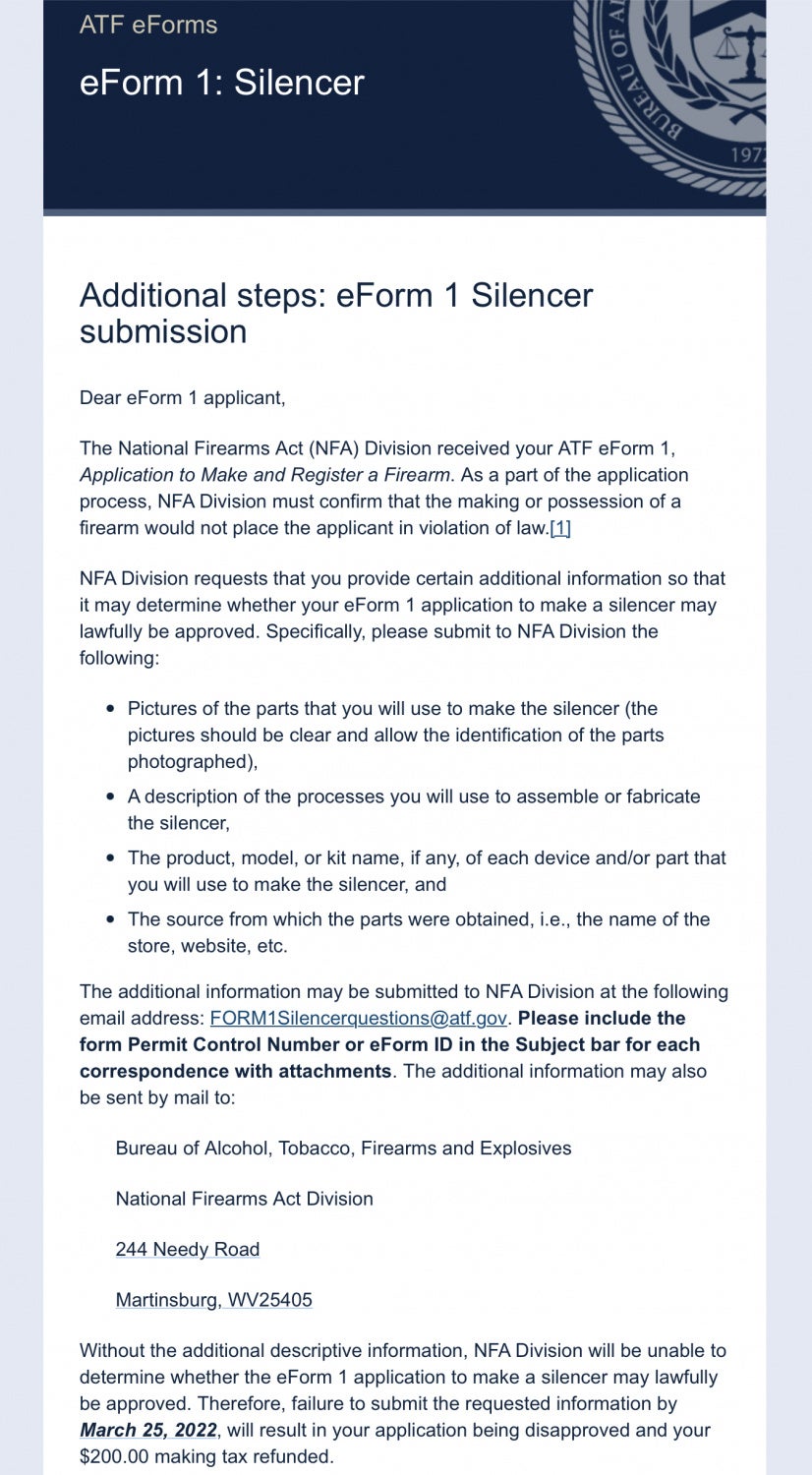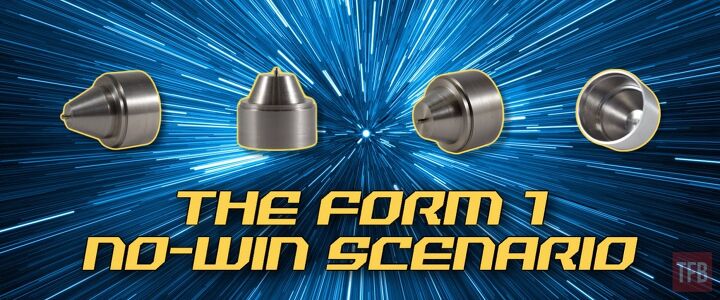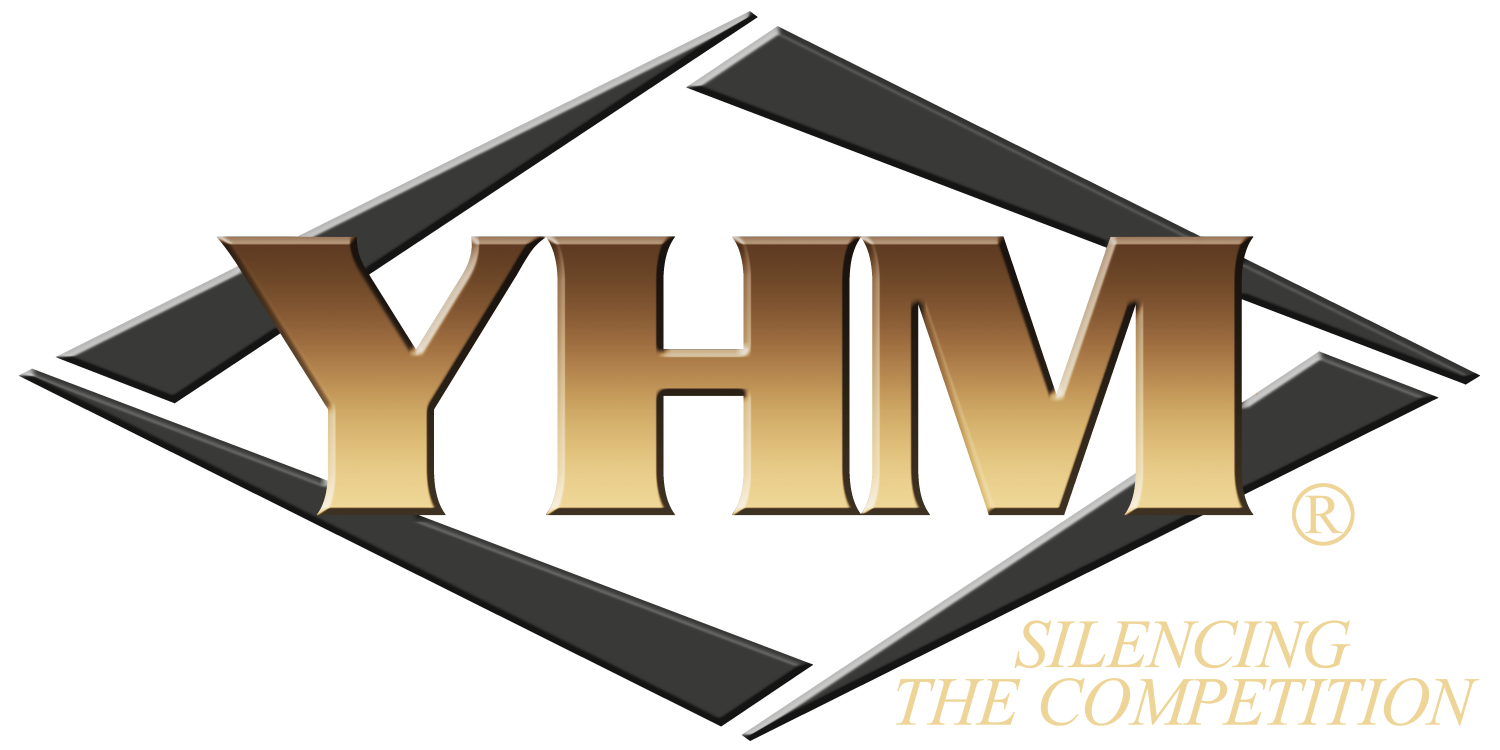Good afternoon everyone and thank you for joining us for another Silencer Saturday brought to you by Yankee Hill Machine, manufacturers of the YHM Turbo K rifle suppressor. Last week we swapped wipes in the B&T USA STATION SIX9 pistol. This week we are once again forced to pause silencer reviews for a look at a no-win scenario for Form 1 makers. Recently applicants received an email from the ATF requesting additional information on their plans and materials used to build their silencer. Failure to provide the requested information would result in Form 1 applications being disapproved and the $200 NFA tax refunded. So, what do we do now? Let’s dig in.
Form 1 @ TFB:
- Is the ATF Mass Disapproving Home-Made Form 1 Suppressors?
- Why is my Form 1 “Pending Research” and How does it Affect Processing Time?
- Diversified Machine Website Seized by the ATF – Form 1 Cans Doomed?
- SILENCER SATURDAY #209: Solvent Trapped – The ATF Warning Letter
SILENCER SATURDAY #218: The Kobayashi Maru – The Form 1 No-Win Scenario
Allow me to nerd-out for a moment. In the movie Star Trek: The Wrath of Khan, the opening scene depicts a young lieutenant in a realistic training exercise to rescue a struggling starship. Known as the Kobayashi Maru, the scenario offers an attempt to save a doomed ship (the Kobayashi Maru) in hostile territory putting the Starfleet ship into an outgunned battle that will end in defeat. This no-win exercise is designed to test Starfleet cadet’s resolve under stress. Of course, Captain James T. Kirk was the only one in Starfleet history to beat the Kobayashi Maru exercise.
The NFA Kobayashi Maru is designed to put silencer makers in a no-win situation.
For years, gun owners have used the ATF Form 1 application process to make silencers from any material available. From fender washers to freeze plugs, fuel and oil filters to PVC pipe, legal home-built silencers have been successfully made for decades. These builds have also repurposed certain items, such as “solvent traps”, into working silencers. Until now.
Last week, the ATF disapproved nearly 1,000 Form 1 applications. Their claim was that applicants were already in possession of silencer parts (purportedly solvent traps/parts) that had not been properly transferred and were not allowed to become a Form 1 silencer.

Following the mass-disapproval, the ATF sent the following email to users of the eForm system with Form 1 applications currently in process:
Additional steps: eForm 1 Silencer submission
Dear eForm 1 applicant,
The National Firearms Act (NFA) Division received your ATF eForm 1, Application to Make and Register a Firearm. As a part of the application process, NFA Division must confirm that the making or possession of a firearm would not place the applicant in violation of law.[1]
NFA Division requests that you provide certain additional information so that it may determine whether your eForm 1 application to make a silencer may lawfully be approved. Specifically, please submit to NFA Division the following:
- Pictures of the parts that you will use to make the silencer (the pictures should be clear and allow the identification of the parts photographed),
- A description of the processes you will use to assemble or fabricate the silencer
- The product, model, or kit name, if any, of each device and/or part that you will use to make the silencer, and
- The source from which the parts were obtained, i.e., the name of the store, website, etc.
The additional information may be submitted to NFA Division at the following email address: FORM1Silencerquestions@atf.gov. Please include the form Permit Control Number or eForm ID in the Subject bar for each correspondence with attachments. The additional information may also be sent by mail to:
Bureau of Alcohol, Tobacco, Firearms and Explosives
National Firearms Act Division
244 Needy Road
Martinsburg, WV25405
Without the additional descriptive information, NFA Division will be unable to determine whether the eForm 1 application to make a silencer may lawfully be approved. Therefore, failure to submit the requested information by March 25, 2022, will result in your application being disapproved and your $200.00 making tax refunded.
Questions regarding this email should be directed to FORM1Silencerquestions@atf.gov. If you have additional inquiries, please call 304-616-4500.
In this no-win situation, the ATF is requesting pictures of parts that they have just deemed to be regulated suppressor parts a few days earlier. Again, their logic outlined in the mass disapproval process was that solvent traps could not be made into silencers because the parts were already silencers and were required to be transferred through the NFA Form 4 application process.
It may be self incrimination if you were to supply pictures of parts from a solvent trap that you intended use to build your Form 1 muffler. Furthermore, identifying the name of the kit and the source of the parts used is asking the applicant to incriminate manufacturers of “solvent traps” that have been used for years to legally build Form 1 silencers by thousands of makers in the United States in the past.

Winning the No-Win Scenario
In The Wrath of Khan, Captain Kirk later reveals that he cheated in the Kobayashi Maru, reprogramming the exercise, because he doesn’t believe in no-win scenarios. Is this Form 1 debacle winnable?
First, no laws have changed from when Form 1 silencers were made with solvent trap parts. It appears that overnight, the rules were changed without discussion, a comment period or a determination of a legal definition.
Whether or not you believe solvent traps exist to trap solvents is irrelevant. The real question is, when would a reasonable person assume a silencer has been created? Where is the magical line between bar stock aluminum and completed baffle? Is the formation of a cone enough to create a taxable event? Is anything threaded to a typical barrel thread pitch a silencer part? Does every part of a Form 1 silencer need to be created by the applicant themselves? If so, do you need to mine the raw iron ore and smelt it into usable metals yourself?
Not that my opinion matters, but I believe that the presence of a bore begins to define the creation of a silencer.
It seems ridiculous that we have to ask these questions, but we are talking about law abiding citizens who are following the rules as they know them, paying their NFA taxes and waiting for their approvals. And now they are accused of breaking the law. The arbitrary and capricious nature of the National Firearms Act when it comes to silencers, machineguns, and short barreled rifles all point to an unconstitutional situation that is subject to change with each administration. By definition, this rule of law goes against everything that is right and just.
What should you do if you have received a request for more information about your Form 1 build?
First, remember that I am not a lawyer and this is not legal advice. Seek competent counsel.
- Do not lie. It might be tempting to claim that you are machining all of your own parts when you are in fact using a solvent trap. Don’t. It’s better to say nothing and get disapproved than to lie to a government official.
- Contact your representatives. Tell your story in a professional, organized manner.
- Join the American Suppressor Association and the Firearms Policy Coalition. There is strength in numbers.
I also don’t believe in no-win scenarios. With persistence and knowledge we can make change. Including the repeal of the National Firearms Act. Do not give up.
Be safe, have fun, and we’ll see you back next weekend for another Silencer Saturday.
American Suppressor Association:
WASHINGTON, D.C. – On February 28th, ATF summarily denied 847 Form 1 applications to make a suppressor because they believed the applicants were using solvent trap kits. On March 3rd, ATF notified every applicant with a pending Form 1 suppressor application that they will be required to provide pictures and descriptions of all parts and components that will be used to make the suppressor, or their application will be disapproved.
Despite previously approving thousands of Form 1 applications for individuals and legal entities that have used these kits in recent years, it seems ATF has now decided to change course without any public explanation or justification. What is clear is that ATF has unilaterally decided that the National Firearms Act (NFA) applies to these kits, and therefore any applicant applying to make a suppressor using one might be guilty of a crime.
Rather than publicly explaining their rationale and giving Form 1 applicants time to adjust, ATF has resorted to sending threatening emails to law-abiding Americans who are trying to follow the law – the same way ATF understood the law before March 1, 2022. This type of behind-closed-door rulemaking has to stop.
 Your Privacy Choices
Your Privacy Choices

